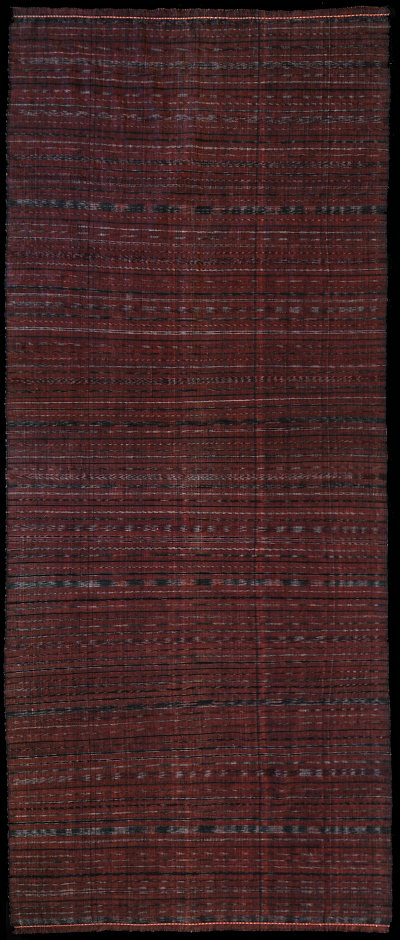| |
 
 | | | |
210 Lombok, Lombok
Sokong (headcloth)  
| | Locale: | Bayan or Sembalun Walang in foothills of Mt. Rinjani, North Lombok; Sasak people, adherents of Wetu Tulu religion. | | Period: | 1920 | | Yarn: | Cotton, hand-spun, fine | | Technique: | Weft ikat | | Panels: | 1 | | Size: | 85 x 209 cm (2' 9" x 6' 10") LW: 2.46 | | Weight: | 395 g (13.9 oz), 222 g/m2 (0.73 oz/ft2) | | Design: | Ceremonial headcloth, called sokong or anak néné ('child of the ancestors'), a type that stopped being made by 1920. Decorated with numerous narrow bands and stripes decorated with subtly shimmering patterns in weft ikat based on ancient patterns. Knotted warp ends, similar in style to those done by the Helong of Timor and Semau, but much smaller. Note that the vertical lines are not creases - the cloth is perfectly flat - but caused by colour variations in the weft that are consistent over the whole length. | | Comment: | Sokong were worn by Wetu Tulu priests, pemangku, for the ceremonial occasion when they went to fetch holy water. It was long assumed that none of these weft ikat textiles survived, and it was quite a sensation when a few showed up in the 1970s and 1980s. Few people are even aware of the existence of these cloths, very few are in private collections. Most went to the National Gallery of Australia and Yale via the hands of fabled collectors Spertus and Holmgren. From the late 19th C. on the Wetu Telu religion and all its manifestations have been suppressed by Lombok's mainstream Muslims, called Wetu Lima, which likely accounts for its immaculate, as new, condition. | | Background: | Chapters on Lombok and Lombok. | | Published: | Ikat Textiles of the Indonesian Archipelago, 2018.
| | Sources: | Very similar to anak néné in National Gallery of Australia, Nr. 1985.1744, depicted in Maxwell, Southeast Asian Textiles, Fig. 222. Also very similar to example dated as 'around 1900' and classed as 'very rare' in Khan Majlis, Woven Messages, Fig. 151. | | |

©Peter ten Hoopen, 2024
All rights reserved.
|
|


